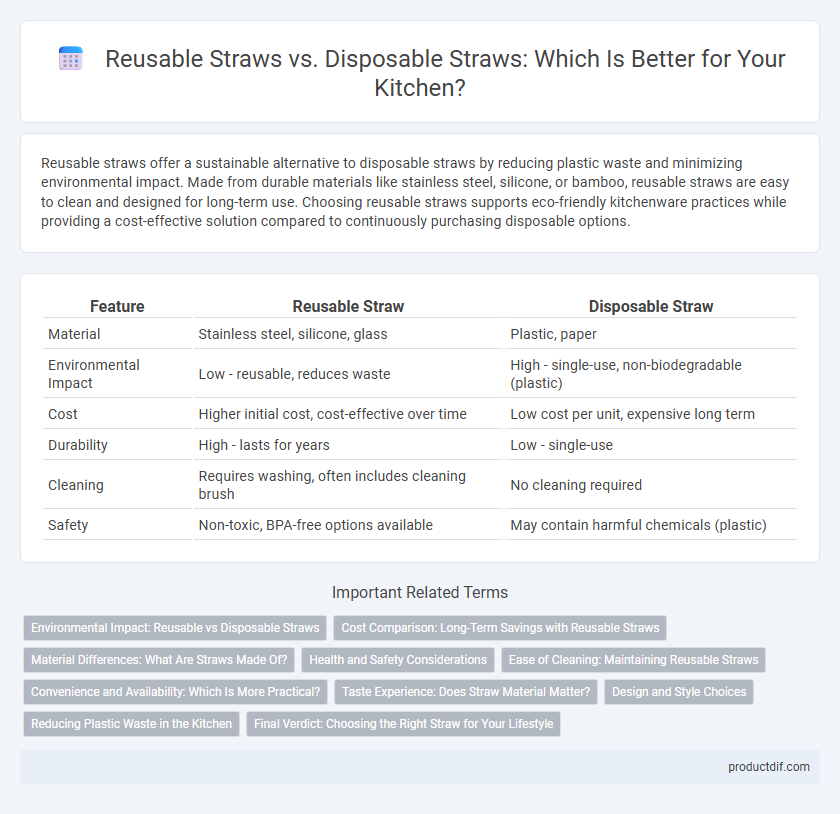Reusable straws offer a sustainable alternative to disposable straws by reducing plastic waste and minimizing environmental impact. Made from durable materials like stainless steel, silicone, or bamboo, reusable straws are easy to clean and designed for long-term use. Choosing reusable straws supports eco-friendly kitchenware practices while providing a cost-effective solution compared to continuously purchasing disposable options.
Table of Comparison
| Feature | Reusable Straw | Disposable Straw |
|---|---|---|
| Material | Stainless steel, silicone, glass | Plastic, paper |
| Environmental Impact | Low - reusable, reduces waste | High - single-use, non-biodegradable (plastic) |
| Cost | Higher initial cost, cost-effective over time | Low cost per unit, expensive long term |
| Durability | High - lasts for years | Low - single-use |
| Cleaning | Requires washing, often includes cleaning brush | No cleaning required |
| Safety | Non-toxic, BPA-free options available | May contain harmful chemicals (plastic) |
Environmental Impact: Reusable vs Disposable Straws
Reusable straws, made from materials such as stainless steel, silicone, or bamboo, significantly reduce plastic waste compared to disposable plastic straws that contribute to landfill and ocean pollution. The durability of reusable straws lowers the demand for single-use products, minimizing environmental degradation and resource consumption. Choosing reusable straws supports sustainable waste management and helps combat the harmful effects of plastic pollution on marine ecosystems.
Cost Comparison: Long-Term Savings with Reusable Straws
Reusable straws offer significant long-term savings compared to disposable straws, as they eliminate the need for frequent repurchasing. While the initial investment in stainless steel or silicone straws is higher, their durability allows for hundreds of uses, reducing ongoing costs drastically. Over time, households and businesses can cut expenses related to single-use straws by switching to reusable options that also minimize environmental impact.
Material Differences: What Are Straws Made Of?
Reusable straws are commonly made from durable materials such as stainless steel, silicone, or bamboo, designed to withstand repeated use and cleaning without degrading. Disposable straws primarily consist of plastic, often polypropylene, which is lightweight and inexpensive but contributes significantly to environmental waste. Some disposable options use paper or biodegradable plant-based materials, though they typically lack the durability and longevity of reusable alternatives.
Health and Safety Considerations
Reusable straws, often made from stainless steel, silicone, or glass, pose fewer health risks when cleaned properly compared to disposable straws that can leach harmful chemicals like BPA into drinks. Sanitation is critical for reusable straws to prevent bacterial buildup, requiring thorough and regular cleaning with specialized brushes. Disposable straws offer a one-time, hygienic option but contribute to environmental pollution and potential ingestion of microplastics if not discarded responsibly.
Ease of Cleaning: Maintaining Reusable Straws
Reusable straws, typically made from stainless steel, silicone, or glass, require thorough cleaning to prevent bacteria buildup and ensure longevity. Specialized brush cleaners and dishwasher-safe designs facilitate easy removal of residue inside narrow openings. Proper maintenance, including regular rinsing and drying, significantly extends the lifespan of reusable straws compared to disposable options.
Convenience and Availability: Which Is More Practical?
Reusable straws offer long-term convenience by reducing waste and being easy to clean with available designs like silicone or stainless steel that fit various cup sizes. Disposable straws provide immediate practicality through widespread availability in cafes, restaurants, and stores with no need for maintenance after use. Choosing between them depends on lifestyle priorities, favoring disposables for one-time convenience and reusables for sustainability and cost-effectiveness.
Taste Experience: Does Straw Material Matter?
Reusable straws, typically made from stainless steel, silicone, or glass, often enhance taste experience by avoiding the plastic aftertaste common with disposable straws. Glass straws provide a clean, neutral flavor, while silicone offers flexibility without altering beverage taste. Disposable plastic straws can sometimes impart a chemical flavor, diminishing the overall sensory enjoyment of drinks.
Design and Style Choices
Reusable straws offer diverse design and style options, including materials like stainless steel, silicone, and glass, each available in various colors and textures to match personal aesthetics. Disposable straws primarily feature simple plastic designs with limited color schemes and shapes, prioritizing convenience over visual appeal. Selecting reusable straws enhances kitchenware style by combining functionality with environmentally conscious design versatility.
Reducing Plastic Waste in the Kitchen
Reusable straws, made from materials like stainless steel, silicone, or bamboo, significantly reduce plastic waste compared to single-use disposable straws commonly made from polypropylene. By replacing disposable straws in kitchen settings, households and businesses can cut down on millions of plastic pieces that contribute to ocean pollution and landfill overflow. Embracing reusable straw options supports sustainable kitchenware practices and promotes long-term environmental impact reduction.
Final Verdict: Choosing the Right Straw for Your Lifestyle
Reusable straws offer an eco-friendly alternative to disposable straws by reducing plastic waste and providing long-term cost savings, especially when made from durable materials like stainless steel, silicone, or bamboo. Disposable straws are convenient for single use but contribute significantly to environmental pollution and resource depletion. Selecting the right straw depends on your lifestyle priorities--opt for reusable options if you value sustainability and durability, or disposable straws for occasional, on-the-go convenience.
Reusable Straw vs Disposable Straw Infographic

 productdif.com
productdif.com